Ground operations in the Falkland War. Part I
34 a year ago, in the spring of 1982, the attention of the whole world turned to the Falkland Islands. For 74 days, Argentina, a country claiming leadership in South America, and one of the leading world powers, the UK, sacrificing human lives and spending billions of dollars, waged a stubborn armed struggle between themselves. This armed conflict between Great Britain and Argentina, called by the British the Falkland War, became one of the largest armed conflicts of the second half of the twentieth century, in which the decisive role belonged to the naval forces. AT stories military confrontations of the second half of the XX century this is almost the only case when the parties to the conflict were equal in strength. Such equality led to a particular fierceness and scale of hostilities. In this article, we will primarily consider ground and landing operations and actions. fleet с aviation to ensure them.
The Argentine leadership of that time, planning an invasion of the Falkland (Malvinas) archipelago, believed that the successful capture (in the interpretation of the Argentines - return) of the islands would increase the popularity of the current regime in the country. The General Staff of the Armed Forces of Argentina has developed a plan for Operation Rosario, which sets out the objectives of the invasion and the tasks of the forces involved, not only the archipelago, but also South Georgia, and even the uninhabited Sandwich Islands, were to be occupied. Preparation for the implementation of this plan required considerable funds. In addition, the United States imposed restrictions on the supply of arms and spare parts for the Argentine Navy and Air Force, which forced Argentina to seek help from Western European countries and to develop its armory industry.
However, events began to outpace the scheduled dates. In the spring of 1982, a group of Argentine workers raised a national flag on the island of South Georgia, for which they were expelled by the local English authorities. British Cabinet, which had intelligence information on the military preparations of Argentina and associated it with the delay in its diplomatic negotiations, March 27 ordered the Royal Navy to prepare to send the first echelon of warships and transports to the south. Nuclear submarines were already rushing to the archipelago, and a bit earlier on the South Georgia the ship of the ice reconnaissance "Endurance" landed a garrison as part of a marines platoon (24 fighter) under the command of Lieutenant C. Mils.
In this situation, the President of Argentina, L. Galtieri, faced the following question: force the beginning of an unprepared operation or abandon it, losing prestige and hope for the return of the archipelago that was taken away from his country by force in 1833 year. Galtieri and his entourage decided that the operation should be started immediately in order to get ahead of the British. At that time, the archipelago was defended by a very small garrison consisting of 87 people, and South Georgia - by 24. This made it possible to take the islands quickly and without serious losses and, winning time during the harsh winter in the South Atlantic, firmly entrenched in them. The huge costs in conducting large-scale hostilities in a region so remote from the metropolis, the prospect of dragging out the war in the north of the Antarctic and the intervention of international institutions should, according to the Argentine leadership, force the UK to abandon its claims to this colony.
With this in mind, 30 March 1982, Argentina launched the operation "Rosario". To participate in it from the ship of the Navy allocated aircraft carrier "Bentisinko de Mayo", the cruiser "General Belgrano", two destroyers, a frigate, a submarine, three tank landing ships and three transport. 2 On April, in 4 h 30 mines in 4 km west of the archipelago administrative center, Port Stanley, in the area of the Moody Brook and Milet Creek, two airborne groups with a total number of 150 people were dropped. Their support was provided by combat swimmers from the submarine Santa Fe.
The governor of the islands, warned of danger, raised the alarm garrison, which since evening had taken positions on the outskirts of the city and in its administrative center, as well as at the airport. However, already at 8 in the morning, Argentine paratroopers broke into the city and approached the port, where their landing squad began to call. Here, the British also resisted and even damaged military transport. Meanwhile, an airborne assault took over the airfield, freed the runway from obstacles and began to receive H-Hercules C-130 transport aircraft. Seeing that further resistance was futile, the governor ordered the garrison to lay down their arms. So, in 8 h 30 min. East Falkland was taken by the sea (750 people) and air (500 people) troopers of the Argentines. He was commanded by General O. Garcia.
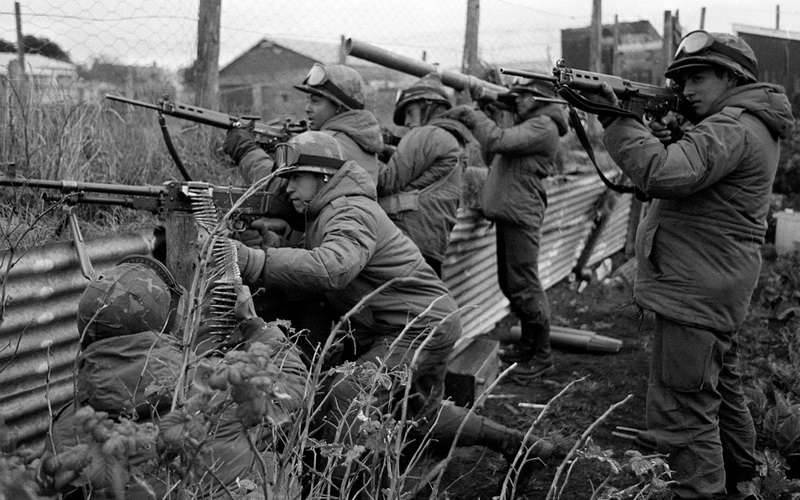
Argentines quickly established control over the entire archipelago and the Sandwich Islands, hastily building up their forces there. The most stubborn resistance was put on South Georgia, where the frigate “Gierico” and transport were sent, and later the submarine “Santa Fe” arrived. However, when the "Hierico" accompanied by two helicopters ("Alouet" and "Puma") entered the Cumberland Bay and headed towards the pier of the village of Grytviken, the garrison opened fire on him from all the available fire weapons. The battle continued for 2 hours, but a manned detachment in 60 under the command of captain A. Astiz made him surrender. In this case, the Argentines lost 4 killed a man, and the British were seriously injured one marine. In addition, the Argentine helicopter was damaged, and the 3 ATGM got into the frigate. He had to return to the continent, but before that, 4 PU with Exoset MM-38 rockets were removed from it at Port Stanley and installed on vehicle platforms, thus creating a mobile battery of GRAVs.
The actions of the Argentines at this stage were well planned and implemented. The commando units and combat swimmers were especially notable: their quick and decisive actions in the night battle and on the march, coordination of the approach of forces, timely clearing of the runway ensured a high rate of build-up of forces and the achievement of an overwhelming advantage over the defenders. Then immediately began the implementation of the second part of the plan - strengthening the defense of the island territories taken.
After making sure that an armed clash with Argentina could not be avoided, the British military office, which included all types of commanders of the armed forces, decided to urgently form an 317-e operational connection, headed by Rear-Admiral D. Woodward. The composition of the compound was well balanced and included only modern ships. The aircraft carriers Hermes and Invincible became the basis of the combat power and stability of the group. The use of the Conkeror, Spartan and Splendid PLA, and later of the “Veliant” and “Koreidzhis”, made it possible to successfully solve the tasks of the naval blockade of the archipelago.
The Argentines had practically nothing to oppose, while the British destroyers, frigates and patrol aircraft could effectively neutralize the Argentine submarines. As a result, the British had the opportunity to determine the scale of the combat zone. True, they did not have enough high-speed fighters to repel attacks by Argentine bombers, but all the ships had an air defense missile system, and the Harrier carrier-based aircraft had air-to-air missiles Sidewinder. In addition, Admiral Woodworth had the necessary forces and means for disembarking operational-tactical scale assault forces. It was provided with a powerful floating rear, consisting of fleet auxiliary ships and mobilized sea vehicles, which was absolutely necessary in the conditions of remoteness of the combat area more f than on 7 thousand miles from the metropolis, as well as the harsh winter.
The transfer of the compound to the area of hostilities was carried out in three echelons, using English on their way. Ascensions, where 10 Vulcan long-range bombers were deployed, Victor and Nimrod patrol aircraft, and by the middle of May the Harrier fighter 22.
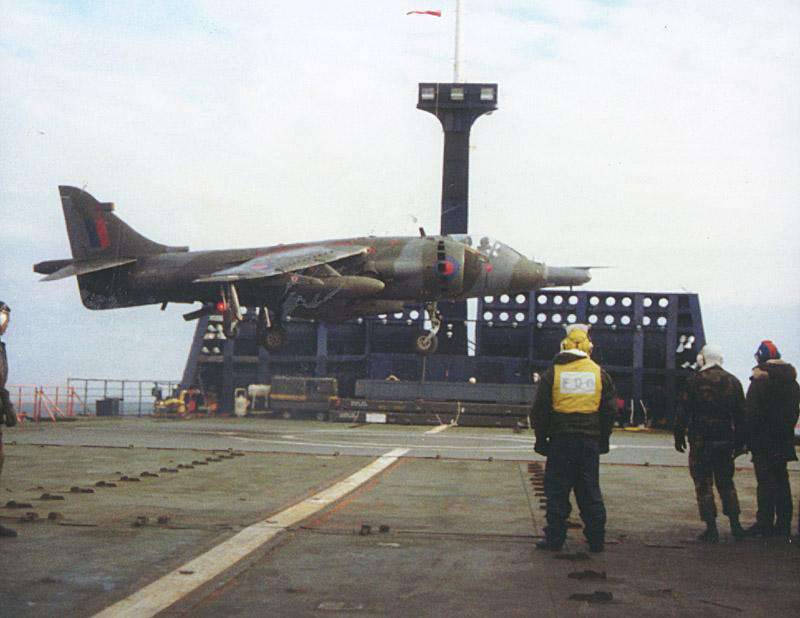
The composition of the first echelon included all the combat-ready forces of the bases of the metropolis and in Gibraltar - a total of 25 ships and 16 transports, including the aircraft carriers Hermes and Invincible. On board were 3500 soldiers and officers of the 3 Brigade of the Marine Corps, 20 X-Harrier and Harrier GR.3 airplanes, as well as 30 helicopters. Forces arrived in the destination area at the end of April. In the first half of April, nuclear submarines carried combat service west of the Falkland Islands (Malvinas). With the start of their patrolling, the archipelago blockade began in the 200-mile zone, announced by the British military office 12 of April.
The second echelon included 14 warships and 9 auxiliary ships. On their board were 1500 marines. Aviation support for the antisubmarine and air defense of the convoy, as well as the transportation of the X.UMX aircraft of the Harrier GR.20 and 3 helicopters, were assigned to the re-equipped Atlantic Conveyor and Atlantic Causeway container ships that arrived in the destination area in the second half of May.
The third echelon consisted of seven destroyers and frigates and 11 auxiliary ships loaded with weapons, military equipment and personnel of the Fifth Infantry Brigade (3000 people). The rest of the transports, ships, and airplanes arrived in the Falkland Islands region through Fr. Ascension alone and became part of the 317 connection.
As a result, for two and a half months (fighting continued 73 of the day) the UK concentrated 99 ships, transports and base craft in the South Atlantic, 70 airplanes and 80 helicopters, 28 000 people - 9000 from them - landing troops.
The Argentine Navy had 44 ships, and together with the Air Force - more than 200 planes and helicopters. The sudden start of hostilities found her fleet unprepared. Of the 14 Super-Etandard 39-deck bombers ordered from France, five or six aircraft arrived at various sources. In their ammunition there were only five EXOZET AM-209 missiles. The crews did not finish training on the development of take-off and landing on the deck of an aircraft carrier. There were no spare parts for other aircraft. Salta, one of two modern submarines of the U-1700 type, was under average repair and before the surrender of the garrison at Port Stanley did not have time to go into operation. Most experienced officers and submariners were sent to Germany to take a training course and receive TR-XNUMX type boats under construction. They also did not take part in the hostilities. The United States, France, Germany, Italy, Belgium, and Israel refused to sell weapons to Argentina, so serious preparation shortages could not be compensated for by deliveries of aircraft, missiles and tanks. The only modern combat-capable submarine "San Luis" went camping with an inexperienced commander and crew.
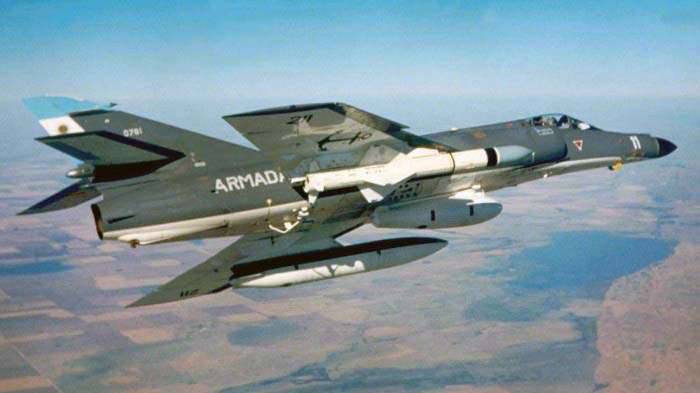
Some of the mistakes of the country's leadership, which directed their efforts not so much at strengthening the defenses of the garrison of the archipelago, as seeking political and diplomatic support at home and abroad, showing that they do not want to spoil relations with the former colonialist of the islands, should be added to these failures. For example, British holdings were not arrested, and the work of British firms, which, by the way, quickly and efficiently transmitted intelligence information obtained by intelligence to London, was not prohibited. In the course of the hostilities, this caused damage to the activity of strike aircraft operating from the continent. Since the country was under the control of a military triumvirate, and the invasion of Falkland (Malvina) was considered an important political act, all three types of armed forces participated on an equal basis. That is why, instead of well-trained marines of the island, parts of the ground forces that were not prepared for this were defended.
In Argentina, soldiers serve in the community. But the command wanted the servicemen from all over the country to participate in this political act. That is why, without any acclimatization, the Fifth Infantry Regiment arrived from the province of Corientes (northern subtropical part of the country) on the archipelago. In this part, the majority of soldiers never saw snow, did not feel the cold, and during the fighting in the conditions of a harsh winter the incidence rate was very high, which greatly demoralized the defense. Moreover, the command did not use the housing stock on the islands for quartering units, so as not to annoy the local population. The soldiers lived in tents. Despite all the efforts of the Argentines, the inhabitants of the islands actively helped the British sabotage and reconnaissance groups. In addition, not all ground forces arrived on the islands with standard heavy weapons. That is why the antiamphibious defense lacked tanks, armored personnel carriers and artillery.
The garrison in the archipelago consisted of 11 000 soldiers. They were commanded by 52-year-old Major General Mario Benjamin Menendez, the former commander of the First Corps (stationed near Buenos Aires). As a land officer, he did not have the necessary training and experience in antiamphibious defense and could not cope with the tasks assigned. The general correctly estimated that his forces were not enough to ensure a complete antiamphibious defense. Therefore, he strengthened thoroughly in the capital, Port Stanley, creating a mine-rocket-artillery position (MRPA) from the sea. It consisted of the Eksoset MM-38 battery from the Girieko frigate, the 152-mm and 105-mm divisions. With unsatisfactory stealth 12 April, the landing ship "Cabo San Antonio" produced a mine in the Barclay Strait and, presumably, in the Cove Bay. He was watched by the English submarine "Spartan". The commander of the boat did not receive permission to attack the Minzag, but his information turned out to be an important argument in choosing the place of the future landing force.
Menendez believed to use aircraft in Port Stanley, as well as located in the pouring zone of airfields in the village of Gus Green and on the island of Pebl, to cover the IRPA and repel the British landing force. The correlation of forces left no doubt that he would have complete air superiority and he intended to use it to build up ground forces in the required direction using transport helicopters. However, the harsh conditions at the beginning of winter and the passivity of the Argentinean commanders did not allow for the expansion of the concrete runway at Port Stanley and the construction of necessary repair facilities and warehouses for the maintenance of bomber aircraft.
Field airfields of the archipelago had even worse conditions. That is why the main part of attack aircraft was based on the continent, and the general had only light IA-58 “Pucara” turboprop and 13 helicopters, which was one of the reasons that the Argentines could not win air supremacy in the combat area.
On the west side of Port Stanley, light defenses were built covering the roads to the city. Port Darwin, Gus Green and Fox Bay also had such fortifications.
Between April 2 and June 14, the fighting can be divided into four main phases: the successful invasion of the Argentine armed forces on the islands; the concentration of forces on both sides in the combat area; blockade and blockade actions of the parties. At the headquarters of the 317 operational connection, they were planned under the code name Operation Corporate; English naval operational and tactical assault forces and an advance to the east, on the only city of the archipelago. They received the general code name of Operation Souton and led to the capture of Port Stanley and the surrender of the entire Argentine garrison.
In response to the concentration of forces 317-th connection in about. Ascension, April 14, two Argentine ship groups, and April 26 - another one, too, went into the ocean and began to move to the islands. The northernmost of them had the aircraft-carrier "Bentisinko de Mayo", which, due to stormy weather, had failed engines and on April X, he was forced to return to the base with his guards. For these reasons, the only hypothetically possible aircraft carrier battle in the history of local wars after 18 did not take place. The middle group of three frigates also could not stand the bad weather and received an order to return to the base. Only the southern detachment continued moving. His flagship "General Belgrano" went to meet his death.
However, the first combat contact took place even before this, immediately after the first British echelon approached Fr. Ascension. On April 21, an amphibious assault detachment, Plymouth, Brilliant frigates and Endurance ice reconnaissance ship headed for South Georgia on the shores of South Georgia. The Wessex III helicopter made radar contact with the maritime radio on April 9 goal in Cumberland Bay on South Georgia. It was an old Argentine submarine “Santa Fe". She completed the task of delivering the necessary materials for the garrison. Then she had to enter the area between the archipelago and Ascension with the task of drowning transports prot According to a report from the Wessex, three Usop 25 helicopters from the Endurance and Plymouth attacked AS-2 missiles and seriously damaged it. One sailor died and another was wounded. Another attack by the Lynx s helicopter followed. Brilliant "who launched the torpedo of the Mk.12 and used the deep projectiles, although the crew had already left the ship. Santa Fe ran aground and later became a military trophy of the 46 connection.
On the same day, a tactical helicopter assault with 14.45 marines began on the same day at 75. Successfully and without loss, overcoming a minefield and not encountering resistance from the garrison, he occupied the island. In 17.15, Argentine soldiers (140 people) laid down their arms. Then the floating workshops of the 317 connection, which provided combat operations in the area, arrived on the island.
After the capture of South Georgia, the Hermes and Invincible aircraft carrier groups approached the Falklands (Malvinas) archipelago, and the blockade of the combat zone became not only maritime but also airborne. 1 May Strategic Aviation with Fr. Ascension, and then the deck with "Hermes" bombed Port Stanley. Air reconnaissance reported - the concrete runway is damaged; The first connection task is completed. Later it turned out that the Argentines purposely poured the earth on some parts of the strip, imitating hits. In fact, the airfield remained in service until the end of hostilities and continued to take transport aircraft from the continent. In the period from 1 to 14 in May, the C-130 Hercules delivered 435 tons of military materials to Port Stanley and evacuated the wounded soldiers to the 264 mainland.
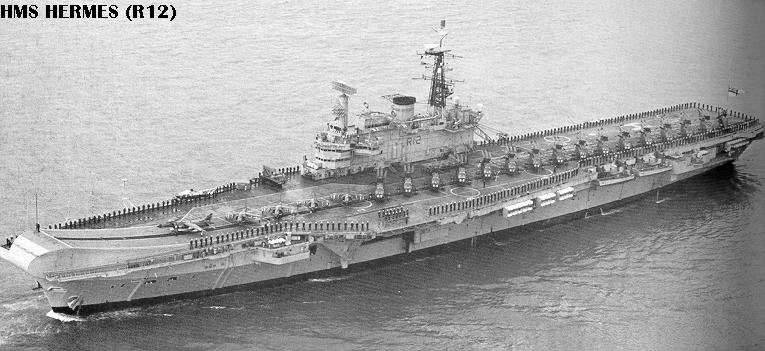
The death of the cruiser "General Belgrano" 2 in May after the torpedo attack of the submarine "Conqueror" significantly limited the actions of the Argentine fleet. The London-declared 200-mile battle zone of May 7 has expanded to the border of Argentina's 12-mile territorial waters. Her warships operated only in this area, and not with very great exertion. So, on May 5, the Trekker patrol aircraft from the Bentisinco de Mayo discovered an English submarine, which was later unsuccessfully attacked by a torpedo from Sea King helicopters. In the pouring zone of the archipelago there were transports of Biaia Buen Suseso, Rio Capcarana, Isla de los Estados, and the trawler Narval conducted reconnaissance near the aircraft carrier forces of Woodward.
On the night from 2 to 3 in May, two armed tugs were sent from the continent to the islands - Comodoro Someller and Alfares Sobral. During their march, the weaknesses of the British naval blockade system were revealed, which included the following elements: nuclear submarines and Nimrod patrol aircraft armed with anti-submarine weapons and Garpun missiles operated on the western border of the 200-mile zone. To the south of the archipelago there was a shipborne radar patrol, and a patrol pair of fighters patrolled over the islands. Aircraft carrier groups maneuvered east of Port Stanley, which hampered the actions of Argentines from the continent of strike aviation.
It was the ships of the distant radar patrol that detected the tugs. The helicopters "Lynx" from the destroyers "Coventry" and "Glasgow" with X-SX CL 834 rockets "Sea Squay" attacked the discovered sea targets and achieved three hits from four launches. As a result, “Comodoro Somer” exploded and sank, and “Alfares Sobral” was damaged, but managed to reach its base. This was the first successful attack of the Sea Skye.
To be continued ...
Sources:
Woodward D. The Falklands War. Simferopol: Share, 2005. C. 24-26, 247-253.
Mityaeva E. The Anglo-Argentine conflict over the Falkland Islands (Malvinas). M .: International Relations, 1985. C. 4-7, 42-45.
Biryusov A. The Anglo-Argentine Conflict // Foreign Military Review. 1984. No.5. C. 12-19.
Kozhukharov A. Landing in the South Atlantic Crisis // Sea collection. 1995. No.6. C.70-74.
Usikov A. Some lessons and conclusions from the Anglo-Argentine conflict // Military History Journal. 1983. No.4. C.67-73.
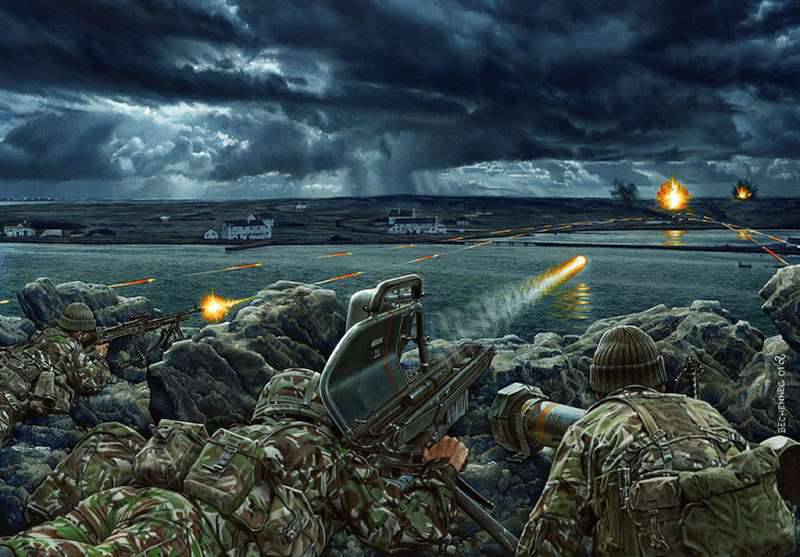
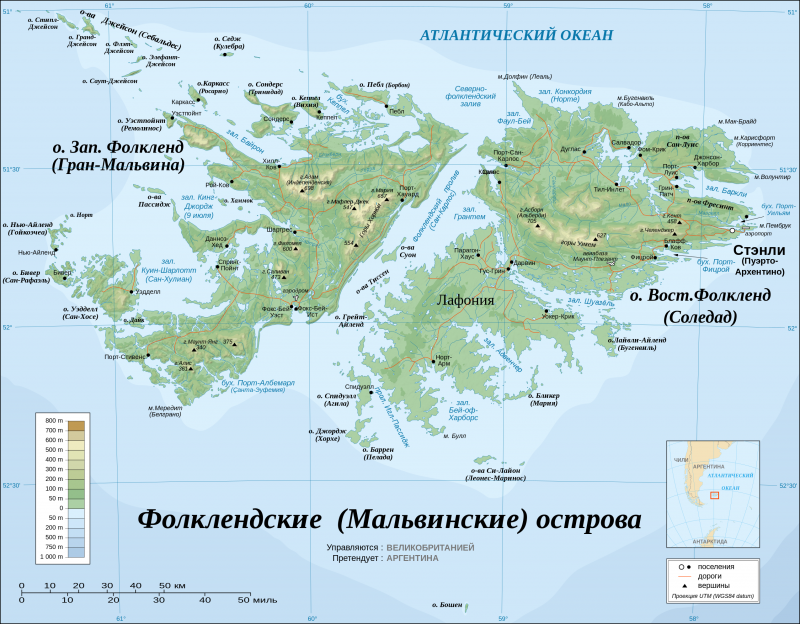
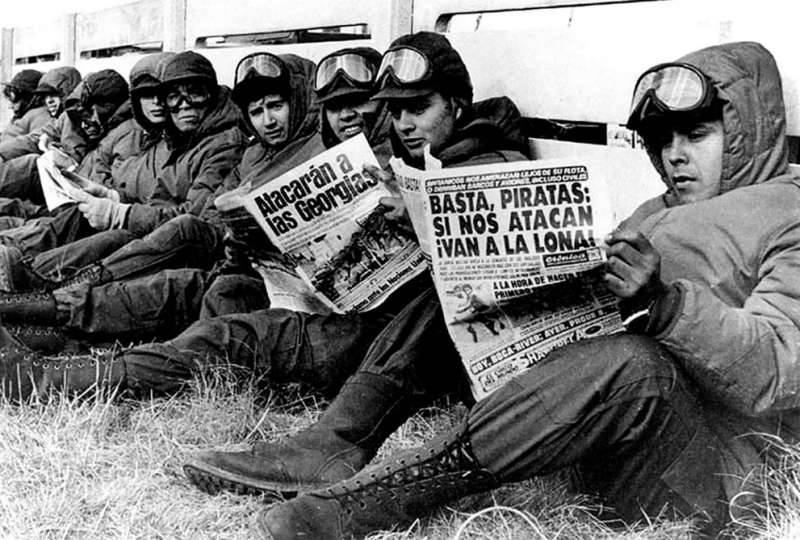
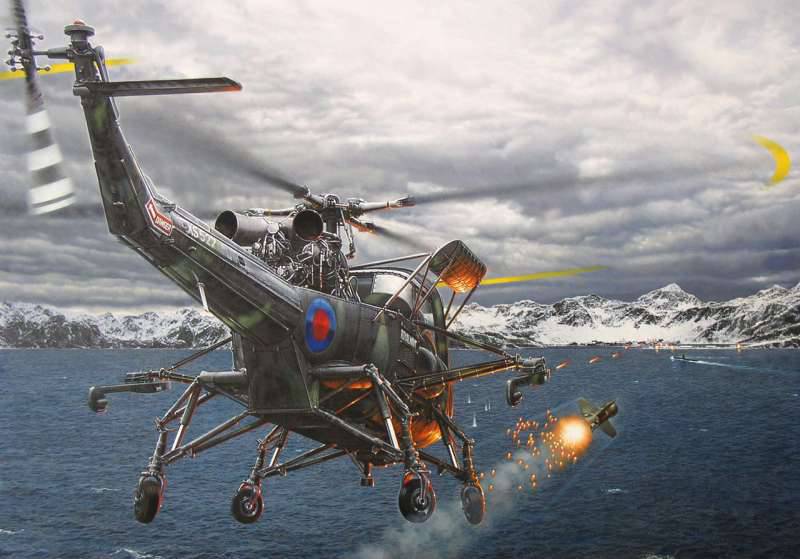
Information